This has been one of the most spectacular years I can remember for coyote bush brush, Baccharis pilularis.
With many plants still dormant from a long season with no rain, the perky green baccharis with their over the top heads of white seeds stand out. They look especially amazing with the sun behind them, lighting up the masses of seed.
Here’s a closeup of a stem swarming with seeds…
…looking closer…
…and closer still. You can see here that the seeds are attached to the white parachutes that give the plants their white color this time of year in the wilds. These photos were taken in Tecolote Canyon, a few blocks from my house, this past Friday, one day before our first measurable rainfall in 164 days knocked many of these seeds off the plants.
Coyote bush brush is sometimes used in native gardens, occasionally in this upright form, but more often in its prostrate Central California coastal form. The selections ‘Pigeon Point’ and ‘Twin Peaks’ are fairly popular. But if you grow the these selections you’ll find that only male plants are used horticulturally, meaning you’ll miss out on this display of seed heads that can begin in late summer and last until the winds and rains disperse them.
For contrast, this is a boy coyote bush brush, sturdy and green with no supplemental water here near the coast. The buckwheats and sage and sagebrush have all retreated to their dormant gray late summer coloration all around him.
And a closeup of his dried flowers. Nothing nearly so spectacular as his sisters this time of year. But he’s got one advantage in that he’s not filling the air with parachutes of seed blowing everywhere like his messy sisters.
Male or female, coyote bush brush plays host to more interesting beneficial local bugs than you’ll see on almost any other plant. I’ll be starting some of these from seed this year in hopes of getting one of these spectacularly messy female plants. Down-wind four houses from me is the canyon, so seed dispersal shouldn’t be a problem.
For further reading: In Praise of Baccharis pilularis, at Town Mouse and Country Mouse.

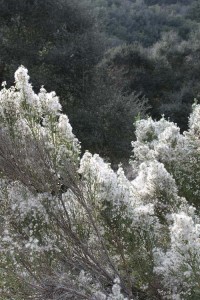
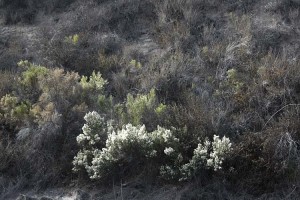
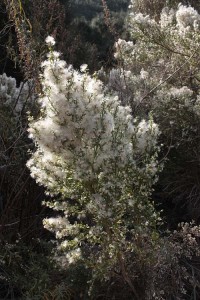
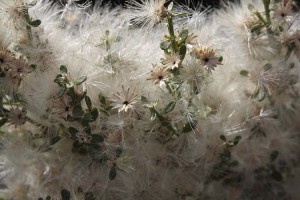
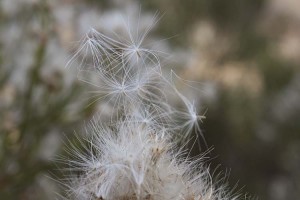
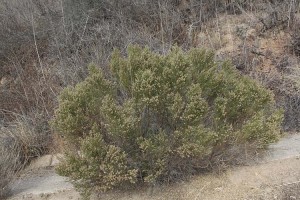
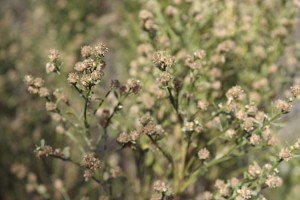
Good post, great detail.
The eastern version, Baccharis hamilifolia, has bloomed here all month, getting fluffier all the time.
Baccharis hamilifolia
What a lovely post, James! I’ve had a little crush on Baccharis ever since reading Judith Larner Lowry’s
‘Gardening with a Wild Heart.’ Here in Northern Cal it is a common site along freeways and other open spaces, and the scent of its leaves on a warm day will always be a quintessential California smell to me. Thanks!
Nice post!
“…you’ll find that only male plants are used horticulturally…”
I didn’t realize that only the male plants were propagated in the trade. Do you have any idea why that is? Maybe you meant just the two cultivars that you mention. The Payne Foundation web site lists five cultivars and two might be female, judging by the descriptions – ‘Chablis’ and ‘Twin Peaks 1’. The other three seem to be male.
A recent read suggested that plants propagated by cutting (the book was about trees, but I assume it applies generally) such as the Baccharis selections available in the trade could be susceptible to old age. Since they are all roughly the same age, there is the possibility that they will all die at the same time and that particular selection will no longer be available. If I recall correctly, this has been observed with strawberries. I wonder if it’s reasonable to worry about this.
Incidentally, I used to mountain bike in Tecolote Canyon. San Diego’s canyons are wonderful.
I do enjoy coyote bush! I have been told that they use male selections because people don’t like the “messy” seeds that fly around and sprout everywhere. At Rancho there is a cultivar called Centenniel that goes crazy with the white fluff right around this time of year. People always ask about it. It is fairly upright with a very rounded shape – about 5 ft x 5 ft. It is a cross between pilularis and sacothroides.
I find it surprising that TPF carries Twin Peaks #1 – I didn’t know it was available anywhere. The more common choice is Twin Peaks #2. Both are male and were created at Rancho.
Nell Jean, thanks for pointing out your own baccharis species! When it’s not covered with white fuzz you might have a hard time guessing it’s in the same genus as many of the baccharis species we have.
Laura, it’s nice that you have baccharis to enjoy too. With so many California natives confined to limited areas, it’s nice to have a few species that cross the state, connecting us to areas outside of immediate environs. As with where you are, ours are quick to colonize open and newly disturbed spaces–like roadside.
Brent, I’ve heard about animal tissue having only a certain number of replications it can make before it starts to fail. I wonder if there’s a similar thing going on in plants. I do have a sterile rose variety that dates to at least the early 1800s if not earlier, so with that species the amount of reproduction time must be centuries. And then there are stories of some species of bamboo, where the entire species blooms at once, all over the world, and all the plants die, only to be propagated by the seed they produce. I’m glad you had a chance to explore Tecolote on mountain bike. It’s definitely one of the better local canyons to explore that way.
Barbara, I’d hear about Centennial but wasn’t aware that it was either a female cultivar or a seed-grown one that would be either male or female. I wonder if our local coyotes have some sarothroides ingression going on since both species grow here and most of the plants seem to be leaner than what I think of being the more classic pilularis, but then again that could just be the climate or our particular strain of coyote.
Spectacular! I’ve seen them while hiking during the last week, but we’re a little behind here up North. And the ones in my garden are clearly boys, and not looking very impressive. Interestingly, I’ve got one in part shade and it’s greener and more attractive than its full sun cousins.
Nice collection of Coyote Bush photos. I’ve been enjoying their show this year. We find them volunteering in most of the gardens we work in on the inland side of the hills. They are a nice plant for to mark the fade into the untended section of the yard. One of the most important habitat plants in the state and one of the most unappreciated.
Thanks for the info, they are blooming like crazy down here too. I did not remember seeing them this prolific either. I really didn’t know what they were in my zipping around town drive-bys, now I will have more appreciation.
James, beautiful camera work, as usual. My sinuses got a little misty just seeing those bad boys – er, girls – all fluffed out like that. I also love the plant and rate it as under rated as is Apache Plume in terms of bloom beauty. Nice post. Oh, my daughter is now living in your fair town! LOL, you’ll know her by her talkative nature. Yeah – that’s the one.